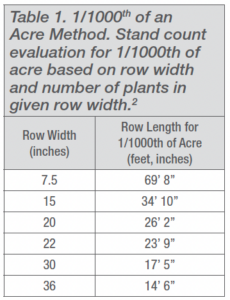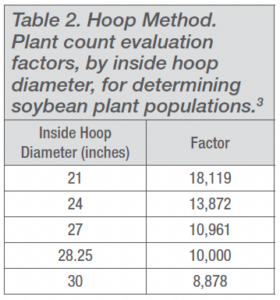Potential yield estimates for a soybean crop can be determined at the R5 growth stage, but estimates made at the R6 growth stage (maturity) or later are usually more accurate. Yield potential is an estimate of four components:
- Number of plants/acre
- Number of pods/plant
- Number of seeds/pod
- Number of seeds/pound
Value of Yield Potential Estimation
Estimating yield potential can provide valuable information that can be used to formulate decisions regarding storage, drying costs, and marketing. In addition, while gathering yield potential information, the field can be inspected for weed density, insect, disease, and animal injury. Evidence of water, hail, and other environmental issues also can be found. As an example, loss of population due to ponding could help influence a drainage decision.
Steps to Estimate Potential Yield
Number of plants/acre
The method used to estimate plants/acre will depend on how the field was planted. Counting the number of plants per length of row can be used if the soybeans were planted with a row planter. The number of plants per unit area is used if the field was planted using a small grain drill. These methods, particularly the hoop method, can be used in the spring when plants are smaller to determine plants/acre, and a record is kept for use in the fall to help estimate potential yield. The 1/1000th acre method determines plants/acre by counting the number of plants in 1/1000th of an acre (Table 1) and multiplying that number by 1000. The hoop method involves determining the diameter of a hoop, tossing it randomly in the field, and counting the number of plants inside the hoop (Figure 1). Multiply the number of plants within the hoop by the appropriate factor in Table 2 to determine the number of plants/acre. If making a hoop, an appropriate diameter is 28.25 inches, which allows for multiplying by 10,000. The hoop can be made by cutting a tube, such as anhydrous tubing, to a length of 88.75 inches and adjoining the ends. Regardless of method, several counts should be obtained at random locations across the field to estimate a final plant/acre average.


Pods Per Plant and Average Seeds Per Pod
The average number of pods/plant can be obtained by counting the number of pods with at least one seed on 10 consecutive plants (don’t skip small plants) at the locations where the number of plants per acre were determined.1 Divide the number of pods by 10 to get the average pod count. The average seeds/pod can be calculated by selecting 10 random pods, from the 10 plants, and counting the seeds in each. Dividing the total number of seeds by 10 provides the average seed/pod count for that location. Healthy plants can average about 2.5 seeds/pod while those under stress will have less.
The seeds/lb calculation can be challenging. A value of 2,500 seeds/lb is indicative of a healthy plant.1 Stressed soybean plants may have smaller seed; therefore, a higher seeds/lb number should be used when calculating yield potential. To estimate the average potential yield (bu/acre) use the following formula where the standard of 1 bu of soybean seed weighing 60 lb is used:
((plants/acre x pods/plant x seeds/pod) ÷ seeds/lb)) ÷ lb/bu = average bu/acre. Example: ((134,000 plants/acre x 24 pods/plant x 2.8 seeds/pod) ÷ 2,500 seeds/lb) ÷ 60 lb/bu = 60 bu/acre average.
Adding the average yields from each location that was sampled and dividing by the number of locations provides the overall estimated average yield/acre for the entire field.
